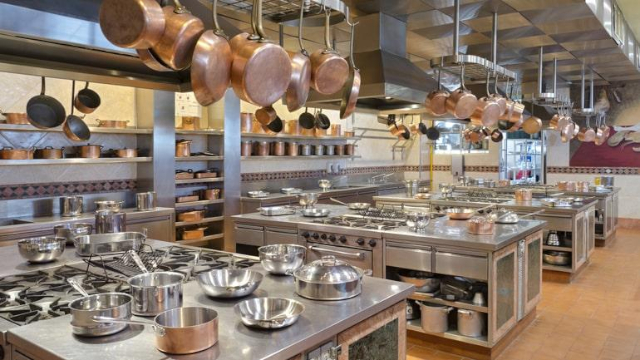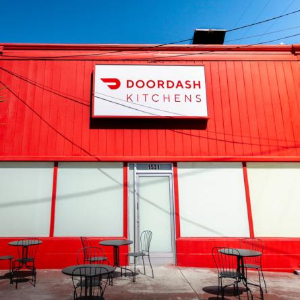It’s sneaking up on us – probably because it has a name but no sign on which to display it. And the Kitchen Hub folks like it that way. That’s because they provide ‘ghost kitchen’ facilities for conventional and delivery-only restaurants with strategically-located production facilities…
 A typical Ghost Kitchen, with rentable prep and cooking nodes…
A typical Ghost Kitchen, with rentable prep and cooking nodes…
Diners who stay home and order by app don’t care whether their resto of choice has a bricks-and-mortar location. They just want their fave menu items, made the way they expect them. Restaurant operators love bot having to build and maintain front-of-house dining rooms and pay associated staff. It sounds like a win-win. Except for the resto workers who are out of jobs.
But there’s an unprecedented shortage of restaurant jobs across the developed world, triggered by the COVID crisis which caused the closure of most dine-in restaurants for months. And many former resto workers have moved on to other careers.
An unsuspected solution
It started when restos closed by COVID protocols started offering special menus aimed at pick-up and delivery customers. That kept their kitchen and management staffs employed and paid the bills that come very month, pandemic or not.
Gradually, some restos found they could not only survive but thrive under the new regime. And now, many new restos are opening, taking the delivery-only route.
‘Ghost Kitchens’ not all that spooky
They’re called Ghost Restaurants, and they employ Ghost Kitchens – cooking and shipping facilities that have no dining room and no serving staff – just the essential kitchen and management people.
Some former conventional restos have converted to delivery only permanently, and they’re not paening for the old days.
I caught a CBC TV story earlier this week about a well-known fine dining establishment in my town which is going great guns under a Ghost regime. Beckta used to the one of the most sought after reservations in Ottawa. But now, it’s turned its attention to delivery operations, and converted it’s dining room into an assembly line packing Dinner Kits. The day the CBC was there, the menu was lamb shanks confit, prawn lettuce wraps and espresso tarts, plus a wine pairing expertly curated by Beckta’s renowned cellar. The kits would be delivered later in the day by the resto’s own in-house driver corps.
Unsuspected benefits
Aside from the obvious benefits of going Ghost, Beckta owner Stephen Beckta points out that he and his staff can now work when it’s convenient for them, not when it’s convenient for the clientelle.
“For me personally now, my workday is probably eight-to-six most days,” he said. “I used to do a lot of nights in the restaurant, so I get to see my family a lot more than I used to.”
And delivery orders keep Beckta so busy that it recently discontinued lunch service to concentrate on the dinner kits. But rather than taking a revenue hit, Beckta says his operation is making more money than ever and his staffing numbers are at a record high.
Going Ghost from the start
New restaurants are launching these days that have never had a bricks-and-mortar presence. In fact, some of them use leased kitchens and need only worry about the food and the staff. Kitchen Hub is the leading provider of leased Ghost Kitchen space but is probably just the first of many.
Back on December 27, in Fast Food Week, we spotlighted three new Ghost Kitchen operations backed by high-profile operators.
Perhaps the most high-profile was the new partnership of iconic stoner Cheech Marin and restaurateur Zach Neil to launch a food delivery service for stoners called Muncheechos. Not cannabis-infused foods, but foods designed to quell the munchies. They’re using Kitchen Hub facilities to fulfill their orders.
Then, there was the pizzeria on wheels unveiled by former engineering employees of Elon Musk’s SpaceX operation. Their pizza machine makes your pie and bakes it on the way to your door. In theory, all they need is the truck the robot rides in and a cell-phone to receive orders.
And Chipotle has opened what it calls a digital kitchen with a minimum of staff and a maximum of automation. Could be the Chipotle of the future.
And… Delivery behemoth DoorDash has it’s own network of Ghost Kitchens (see photo, top of page).
All the big players want to go Ghost
For months, now, we’ve seen repeated campaigns by the major Fast Food purveyors aimed at getting folks not to come in to their restos, but to order by internet or app, and just pick up their food on the fly. Some even have delivery deals to encourage customers to stay home.
How long will it take before the Fast Food space is entirely converted to take-out and delivery? I have no idea. But the folks in charge – seeing dollar signs down the road – are obviously trying to hurry the process along as quickly as possible. One thing is sure. The Fast Food sector will be the first to ditch dining rooms al together.
But I also agree with industry experts, that there will always be a few high-end dine-in restos, for folks seeking the waited-on-hand-and-foot experience, or the perfect atmosphere for a special occasion.
~ Maggie J.

